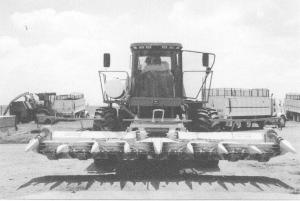2001 - Volume #25, Issue #1, Page #17
[ Sample Stories From This Issue | List of All Stories In This Issue | Print this story
| Read this issue]
Home-Built Choppers Cost Less Than Factory Built
 |
 |
Since that time, the men have built several more self-propelled rigs including two new, bigger choppers that were added to their fleet last summer.
"We've now built five machines," Larry says. "We sold the first one, but we still use the other four." He says they average between 500 and 600 hours per machine per year.
The choppers were all built from the ground up, using their own design that incorporates a number of readily available components. Some of the components, like engines, they buy new. Others, they locate in salvage yards. The shop-built rigs still aren't cheap, at about $130,000. But because they select components carefully, operating and repair expenses are lower than with factory-built machines they've used in the past.
Larry describes the choppers as sort of a hybrid between a Claas and a Deere. "Ours has a drum cutter, similar to Deere, but the engine is transverse mounted, like in a Claas," he explains.
They start with a 4 by 10-in. steel tube frame of their own making and add the drive axles and transmissions from Gleaner N7 combines. The rear axles came off International 1680 rotary combines.
"We picked these axles because we could find them in salvage yards. We've had no trouble with them, and evidently other people don't either, since salvage yards tell us they don't sell many of them," he says.
While the cutter drums may be similar to Deere's, they're about 2 in. bigger in diameter and 7 in. wider, with 12 more knives on it than the Deere drum.
To power their two latest choppers, the Froese brothers bought new 600 hp 3456 Caterpillar diesels with the clutch as part of the package.
The Froese chopper design puts the engine behind the cab, mounted transversely. That way, they don't need a gearbox to change the direction of the power drive. "This is one of the things that makes our chopper simpler. Not only is it less expensive to build this way, it's also less costly to maintain," Froese says.
To keep the engine cool, they add an oversized radiator that uses engine coolant and air-to-air cooling, assembled for them by a local radiator shop. The 50 gal. capacity radiators are mounted on the rear of the choppers, to blow hot air and noise away from the machine. The radiator fan is hydraulically powered.
They used cabs from Deere 9600 combines on their two latest choppers. In the past, they'd used Gleaner L combine cabs, but they were able to find the Deere cabs for the right price.
For electrical controls, they used circuit boards from Deere 9600 combines, too. "They're integrated into the cab as part of the arm rest," Froese tells. "Not everything in the board worked like we wanted it to, though, so we cut some of the circuits and resoldered them to make them do what we wanted."
They use 8-row Austrian-built Kemper headers on their new choppers. Their first choppers had 6 row headers.
A 20-gpm hydraulic pump powers the header. Froese says they opted for hydraulic drive because it allows them to power up the headers without having to reduce engine speed.
The new choppers are also equipped with kernel processing rolls, which they purchased from Automatic. The kernel processors can be removed or installed in only about 20 minutes.
On the front axle, they mounted 650 metric tires, even though they had to hunt for the right wheels to fit them. "These tires are narrow enough to fit between 30-in. rows, so we don't have stalk damage to the tires, but they're flat across the surface rather than rounded, so they give you as big a footprint as a 30.5 by 32 tire. In addition, then can run with 5 to 10 lbs. lower air pressure and still support the same amount of weight," he explains.
On the rear they used 18.4 by 26 lugged tractor-type tires.
The choppers need about 28 gal. of fuel per hour when working at peak capacity, which, Froese says, means they'd need a 40

Click here to download page story appeared in.

Click here to read entire issue
To read the rest of this story, download this issue below or click here to register with your account number.




